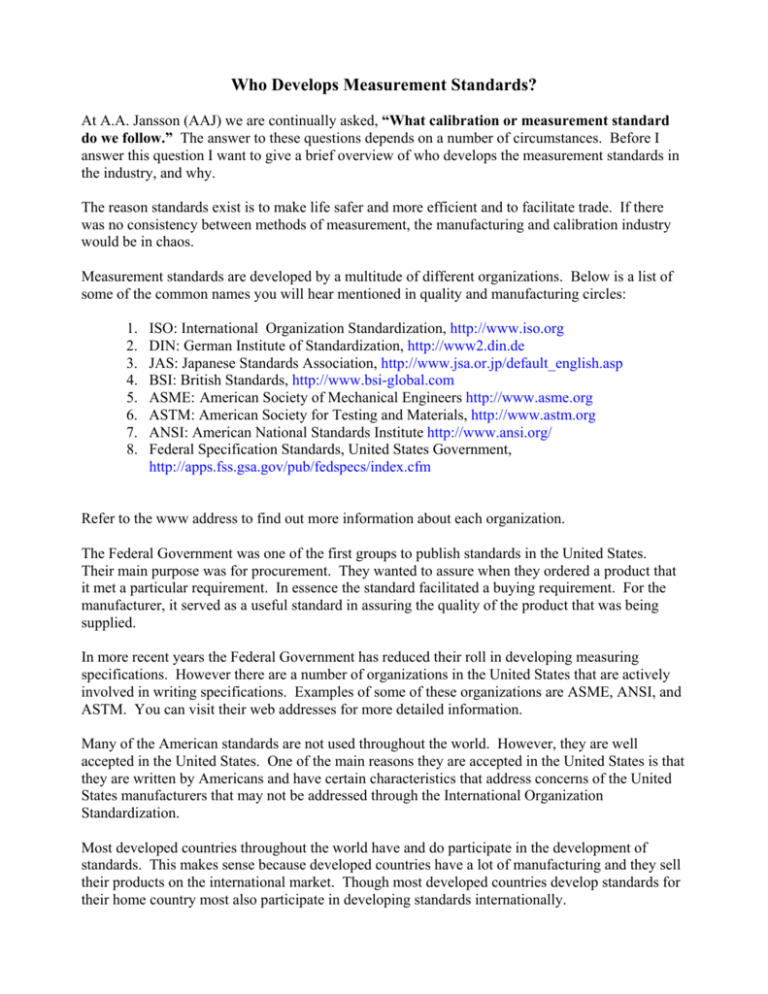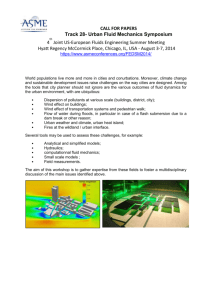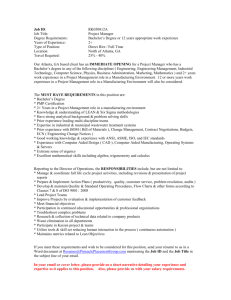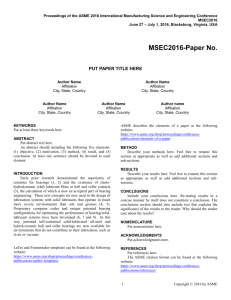Who Develop Measurement Standards
advertisement

Who Develops Measurement Standards? At A.A. Jansson (AAJ) we are continually asked, “What calibration or measurement standard do we follow.” The answer to these questions depends on a number of circumstances. Before I answer this question I want to give a brief overview of who develops the measurement standards in the industry, and why. The reason standards exist is to make life safer and more efficient and to facilitate trade. If there was no consistency between methods of measurement, the manufacturing and calibration industry would be in chaos. Measurement standards are developed by a multitude of different organizations. Below is a list of some of the common names you will hear mentioned in quality and manufacturing circles: 1. 2. 3. 4. 5. 6. 7. 8. ISO: International Organization Standardization, http://www.iso.org DIN: German Institute of Standardization, http://www2.din.de JAS: Japanese Standards Association, http://www.jsa.or.jp/default_english.asp BSI: British Standards, http://www.bsi-global.com ASME: American Society of Mechanical Engineers http://www.asme.org ASTM: American Society for Testing and Materials, http://www.astm.org ANSI: American National Standards Institute http://www.ansi.org/ Federal Specification Standards, United States Government, http://apps.fss.gsa.gov/pub/fedspecs/index.cfm Refer to the www address to find out more information about each organization. The Federal Government was one of the first groups to publish standards in the United States. Their main purpose was for procurement. They wanted to assure when they ordered a product that it met a particular requirement. In essence the standard facilitated a buying requirement. For the manufacturer, it served as a useful standard in assuring the quality of the product that was being supplied. In more recent years the Federal Government has reduced their roll in developing measuring specifications. However there are a number of organizations in the United States that are actively involved in writing specifications. Examples of some of these organizations are ASME, ANSI, and ASTM. You can visit their web addresses for more detailed information. Many of the American standards are not used throughout the world. However, they are well accepted in the United States. One of the main reasons they are accepted in the United States is that they are written by Americans and have certain characteristics that address concerns of the United States manufacturers that may not be addressed through the International Organization Standardization. Most developed countries throughout the world have and do participate in the development of standards. This makes sense because developed countries have a lot of manufacturing and they sell their products on the international market. Though most developed countries develop standards for their home country most also participate in developing standards internationally. The International Organization for Standardization (ISO) is the world’s largest developer of standards. Subsequently most developed countries organizations that manufacture and develop standards participate or are members of the ISO. ISO is a network of the national standards institutes of 156 countries, with a Central Secretariat in Geneva, Switzerland, that coordinates the system. ISO is a non-governmental organization: its members are not, as is the case in the United Nations system, delegations of national governments. Nevertheless, ISO occupies a special position between the public and private sectors. This is because, on the one hand, many of its member institutes are part of the governmental structure of their countries, or are mandated by their government. On the other hand, other members have their roots uniquely in the private sector, having been set up by national partnerships of industry associations. Therefore, ISO is able to act as a bridging organization in which a consensus can be reached on solutions that meet both the requirements of business and the broader needs of society, such as the needs of stakeholder groups like consumers and users. Now to answer the question, “What calibration or measurement standard does A.A. Jansson follow?” This is a little more difficult to explain. In the case of Gage Blocks we follow the ASME specification. The standard is named ASME B89.1.9-2002. This is published by The American Society of Mechanical Engineers. It is a very well accepted standard. It has been developed and continually updated over a number of years. It parallels many aspects that are in the ISO standards. Prior to ASME B89.1.9-2002 and the earlier version published in 1991, most Gage Block Manufacturers followed the Federal Specification. The Federal Specification was GGG-G-15B. More recently the US Gage Block Manufactures decided to follow the ASME standard and no longer manufacturer to the Federal Standard. Calibration service companies are following suite. In the case of surface plate calibration the industry follows the Federal Specification GGG-P-463C. However the ASME has been working on an update for this specification. The ASME should be publishing the standard in the near future. The new specification will be very similar to the Federal Specification. Their will be some changes that will help users understand the specification thus making it more useful. The ASME will also clarify and build on the technical issues within the document. There is no current standard that the industry follows for the calibration of Optical Projectors (Optical Comparators) and, Video Based Coordinate Measuring Machines. However the ASME is working on specifications that will be published in the future. In the mean time AAJ and other calibration service companies have their own calibration procedures. Many service companies will make claims that they follow the manufacturers’ specifications. However not all service companies are performing the calibration in the same way and to the same extent. In this case, as an end user you must use extreme caution. Many companies will give you a certificate that reports linear accuracy checks. However they will not report squareness errors or magnification and angle errors. In many cases these companies will report information and will not make corrections. This is the difference between a $195 calibration and $70 to $100 calibration. I cannot tell you how many times that I have walked into a company for the first time to trouble shoot a problem and the problem relates to the measuring equipment. I will ask for a current calibration report. The customer assures me that the machine is calibrated regularly. However, when I read the report I find that the comparator has errors in the neighborhood of .005” and the manufacturer has a gauging tolerance of ±.001”. In essence they had error in the measuring equipment 5 times the stated tolerance that they are trying to gauge. Regardless of whether or not your calibration service provider follows a published specification, make sure you read your calibration report and understand what it says. This is a must to insure the quality of your process. Refer to our Resource Center, or the above list to find out where to purchase standards and specifications.




